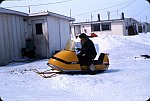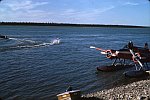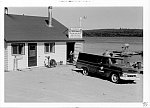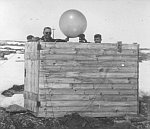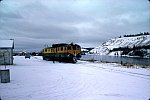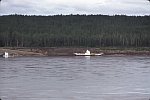Transportation in the North
Author: Jennifer Jozic Page 1 | Page 2 | Page 3
Northern Transportation Today: Snowmobiles, Airplanes and the Occasional Train
Snowmobiles roared into the Canadian North in the 1960s.
By the end of the decade they had become the preferred mode of winter land travel.
Trappers, prospectors, mining companies and the Royal Canadian Mounted Police all
found that the machines required less care, were cheaper to maintain and moved
much faster than traditional dog teams – as long as they did not break down.
Three decades later, snowmobiles remain the most economical way to transport people and
light loads over the northern snow.
In many ways, they serve the same purpose that dog sleds once did. Many hunters still drive their snowmobiles along ancient dog sled routes, combining old traditions with new technology. Snowmobiles can move much faster than dogsleds but are not necessarily as practical. In the event of a mishap, the snowmobile is useless unless it is in working order; it also requires gas and certainly could never provide lunch!
Skiing, either downhill or cross-country, has become a popular pastime. Downhill skiing is not possible everywhere but it is common in British Columbia and Yukon. You can even find people waterskiing behind motorboats in the summertime.
One hundred years ago getting from Europe to Northern Canada and back again was a seven-year round trip! Today it can be accomplished in a matter of hours. Air travel totally transformed how Canadian regions are able to interact. During the 1920s and 1930s the federal government became inspired by the role aviation could play in developing the North. During this period Canada led the world in the transportation of air cargo, almost all destined for northern Canada.
Most long-distance passenger travel in the north is now done by air, and most northern airplanes are operated by companies that cater to local residents. A few larger airlines also maintain regular routes to the north with the major air hubs being Whitehorse, Yellowknife, Resolute, Rankin Inlet and Iqaluit. This postcard from Norcanair reveals how quaint, appreciated and picturesque air travel is considered to be.
Bush planes and helicopters have opened up vast stretches of the Canadian North. Before helicopters arrived (in the 1950s) surveyors, prospectors, and scientists usually worked only in areas where bush planes could land. Because helicopters are able to land almost anywhere, it is now possible for these people to work in previously inaccessible regions. The introduction of helicopters has significantly accelerated the mapping, surveying, and geological exploration of the North.
Train lines are not widely available across the North and where they do exist, they generally pull cargo rather than people. Railways can move larger loads farther distances in shorter times than by most other methods of transportation. Unfortunately, building the tracks and stations for trains can be an enormous and expensive undertaking.
The development of the White Pass and Yukon Route linked the port at Skagway, Alaska to Whitehorse with 250 km of rail through very dangerous mountainous terrain. It was only considered a priority because of the Klondike Gold Rush of 1898. However, this railway made industrial gold mining industry in that part of the North possible and operations continued until very recently.
Land Vehicles and Ice Roads
Trucks are a tremendous boon but require roads. In the North, roads are sporadic, unreliable and difficult to maintain. Permafrost and the harsh winter weather make it difficult to maintain and repair roads and railways. The Northwest Territories and the Yukon Territories together maintain 6000 km of highway. They are often long gravel roads and have little traffic although parts of the Alaska Highway, Klondike Highway, Haines Road, Hay River Highway and the Fort Smith Highway are paved. Nunavut has no long distance highways.
Ferry crossings are an integral part of the road system when they are in operation. Ferries usually operate from mid-May to early-November but at the most northerly crossings the season diminishes to June to mid-October. Ice bridges can be started about the middle of December and kept in operation for about two to three months.
Ice corridors make winter travel more direct and accessible. They offer an efficient way to transport large equipment northwards in preparation for summer work, such as mining excavations and constructing buildings. However, ice road travel is not without its drawbacks. Hazardous temperatures, severe winter storms, visibility whiteouts, ice blowouts, overflow, washouts, pressure ridges, cracks, and worn portages all strain the system.
Although frozen rivers and lakes have been used for centuries by Native peoples and the Inuit for traveling and hunting, a collection of ice roads have only recently been transformed into a formalized road network. Public and private ice roads are constructed and maintained each season to transport private, recreational and commercial vehicles into far northern regions otherwise accessible only by barge. To get maximum use of the short hauling season, commercial vehicles ply the ice roads 24 hours a day whenever possible.
